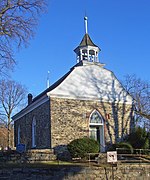Peabody Preserve (Tarrytown, New York)
Hudson Valley, New York geography stubsNature reserves in New York (state)Protected areas of Westchester County, New YorkTarrytown, New York
Peabody Preserve is a 40-acre (0.16 km2) natural land area located in between the Hudson River and Fremont Pond, in Sleepy Hollow, New York, United States. The Preserve contains hiking trails, multiple habitats, wetlands, a retaining pool and diverse species of flora and fauna. The Reserve was created to protect and restore native ecological communities and wetlands, serve as an outdoor classroom for students and teachers, and provide recreational opportunities to all visitors.
Excerpt from the Wikipedia article Peabody Preserve (Tarrytown, New York) (License: CC BY-SA 3.0, Authors).Peabody Preserve (Tarrytown, New York)
Red Trail,
Geographical coordinates (GPS) Address Website Nearby Places Show on map
Geographical coordinates (GPS)
| Latitude | Longitude |
|---|---|
| N 41.1002 ° | E -73.8653 ° |
Address
Peabody Preserve Outdoor Classroom
Red Trail
10591
New York, United States
Open on Google Maps








